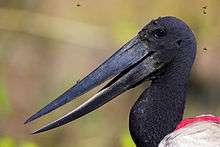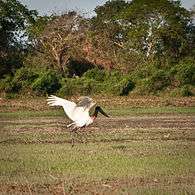Jabiru
| Jabiru | |
|---|---|
| | |
| In the Pantanal, Brazil | |
| Scientific classification | |
| Kingdom: | Animalia |
| Phylum: | Chordata |
| Class: | Aves |
| Order: | Ciconiiformes |
| Family: | Ciconiidae |
| Genus: | Jabiru Hellmayr, 1906 |
| Species: | J. mycteria |
| Binomial name | |
| Jabiru mycteria (Lichtenstein, 1819) | |
The jabiru (/ˌdʒæbᵻˈruː/ or /ˈdʒæbᵻruː/; Latin: Jabiru mycteria) is a large stork found in the Americas from Mexico to Argentina, except west of the Andes. It is most common in the Pantanal region of Brazil and the Eastern Chaco region of Paraguay. It is the only member of the genus Jabiru. The name comes from a Tupi–Guaraní language and means "swollen neck".
Etymology and origins
The name jabiru has also been used for two other birds of a distinct genus: the Asian black-necked stork (Ephippiorhynchus asiaticus), commonly called "jabiru" in Australia; and sometimes also for the saddle-billed stork (Ephippiorhynchus senegalensis) of Sub-Saharan Africa. In particular, Gardiner's Egyptian hieroglyph G29, believed to depict an E. senegalensis, is sometimes labeled "jabiru" in hieroglyph lists. The Ephippiorhynchus are believed to be the jabiru's closest living cousins, indicating an Old World origin for the species.[2]
The proposed Late Pleistocene fossil stork genus Prociconia from Brazil might actually belong in Jabiru. A fossil species of jabiru was found in the early Pliocene Codore Formation near Urumaco, Venezuela (Walsh & Sánchez 2008).
In Portuguese, the bird is called jabiru, jaburu, tuiuiu, tuim-de-papo-vermelho ("red-necked tuim", in Mato Grosso) and cauauá (in the Amazon Basin). The name tuiuiu is also used in southern Brazil for the wood stork (Mycteria americana).
Description

The jabiru is the tallest flying bird found in South America and Central America, often standing nearly the same height as the flightless and thus much heavier American rhea. For the continent, it also has the second largest wingspan, after the Andean condor (that is, excluding the great albatross occasionally found off the coast of southern South America).[2] The adult jabiru is 120–140 cm (47–55 in) long, 2.3–2.8 m (7.5–9.2 ft) across the wings, and can weigh 4.3–9 kg (9.5–19.8 lb).[2] Sexual dimorphism is high, possibly the highest of any stork, with males being about 25% larger than females. Males weigh an average of 6.89 kg (15.2 lb) whereas females weigh an average of 5.22 kg (11.5 lb).[3] Large males may stand as tall as 1.53 m (5.0 ft). The beak, which measures 25–35 cm (9.8–13.8 in), is black and broad, slightly upturned, ending in a sharp point. Among other standard measurements, the tail measures 20–25 cm (7.9–9.8 in), the tarsus measures 28.5–39 cm (11.2–15.4 in) long and the wing chord measures 58.5–73 cm (23.0–28.7 in).[2] The plumage is mostly white, but the head and upper neck are featherless and black, with a featherless red stretchable pouch at the base. The sexes are similar in appearance but the male is larger, which can be noticeable when the sexes are together. While it can give the impression of being an ungainly bird on the ground, the jabiru is a powerful and graceful flier.
Life history

Food and feeding habits
The jabiru lives in large groups near rivers and ponds, and eats prodigious quantities of fish, molluscs, and amphibians. It will occasionally eat reptiles, bird eggs and small mammals. It will even eat fresh carrion and dead fish, such as those that die during dry spells, and thus help maintain the quality of isolated bodies of water. They feed in flocks and usually forage by wading in shallow water. Jabirus detect prey more through tactile sensation than vision. They feed by holding their open bill at a 45 degree angle to the water. When prey is contacted, the storks close their bill, draw it out of the water, and throw their head back to swallow.[4] It is an opportunistic feeder. In one instance when house mice experienced a population explosion in an agricultural area, and several hundred jabirus could be seen in each field feeding on the rodents (unusual for a bird that's rarely seen in large numbers anywhere).[2] On rare occasions, jabirus have been seen attempting to kleptoparasitize the two smaller storks it co-exists with, the wood and maguari storks.[2]
Breeding
The nest of sticks is built by both parents around August–September (in the Southern Hemisphere) on tall trees, and enlarged at each succeeding season growing to several meters in diameter. Nests are often deeper than they are wide, they can be up to 1 m (3.3 ft) wide and 1.8 m (5.9 ft) deep.[4] Half a dozen nests may be built in close proximity, sometimes among nests of herons and other birds. The parents take turns incubating the clutch of two to five white eggs and are known to more territorial than usual against other jabirus during the brooding period. Raccoons and other storks (including their own species) are occasion predators of jabiru eggs, but most nest predators appear to avoid these huge-billed birds and there are no known predators of healthy adult jabirus.[4] Although the young fledge around 110 days old, they often spend around another 3 months in the care of their parents. Because of this long length of time spent brooding, pairs have difficulty breeding in successive years. Less than half of active pairs in one season are active the next season. Only 25% of successful pairs are successful the next season. The lifespan average is 36 years.[4]
Conservation
Jabiru are widespread but not abundant in any area. They are considered a species of least concern by the IUCN, an improvement from a status of near threatened in 1988.[1] Jabiru gained protected status in Belize in 1973. Since then, their numbers in that area have slowly risen. They have been granted protected status by the U.S. Migratory Bird Act.[4]
Gallery
References
- 1 2 BirdLife International (2012). "Jabiru mycteria". IUCN Red List of Threatened Species. Version 2013.2. International Union for Conservation of Nature. Retrieved 26 November 2013.
- 1 2 3 4 5 6 Hancock & Kushan, Storks, Ibises and Spoonbills of the World. Princeton University Press (1992), ISBN 978-0-12-322730-0
- ↑ CRC Handbook of Avian Body Masses, 2nd Edition by John B. Dunning Jr. (Editor). CRC Press (2008), ISBN 978-1-4200-6444-5.
- 1 2 3 4 5 ADW- Jabiru mycteria- Information (2011).
Further reading
Walsh, S. A.; Sánchez, R. (2008). "The first Cenozoic fossil bird from Venezuela". Paläontologische Zeitschrift. 82 (2): 105–112. doi:10.1007/bf02988402.
External links
| Wikispecies has information related to: Jabiru mycteria |
| Wikimedia Commons has media related to Jabiru mycteria. |
 "Jabiru". Encyclopædia Britannica. 15 (11th ed.). 1911.
"Jabiru". Encyclopædia Britannica. 15 (11th ed.). 1911.- Jabiru Video Documentary
- Jabiru videos on the Internet Bird Collection
- Mangoverde.com: Jabiru Jabiru mycteria. Retrieved 2006-DEC-06.
- Saúde Animal: Jaburu ou tuiuiú: Espécie animal brasileiro ameaçado de extinção [in Portuguese]. Retrieved 6 December 2006.
- Stamps (for nine countries) with a range map
- Jabiru photo gallery VIREO
- Photo-High Res; Article borderland-tours

